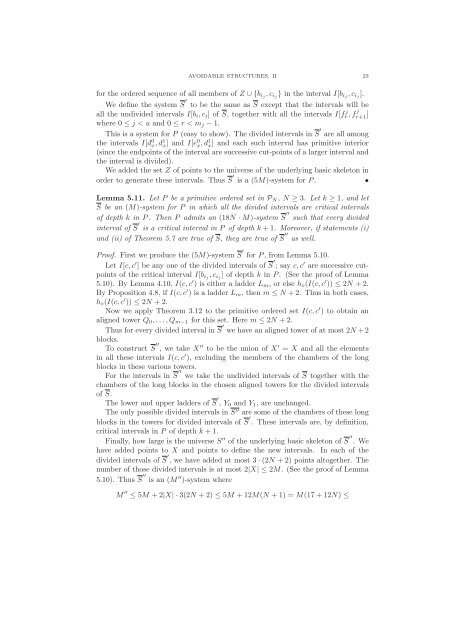Avoidable structures, II: finite distributive lattices and nicely ...
Avoidable structures, II: finite distributive lattices and nicely ...
Avoidable structures, II: finite distributive lattices and nicely ...
You also want an ePaper? Increase the reach of your titles
YUMPU automatically turns print PDFs into web optimized ePapers that Google loves.
AVOIDABLE STRUCTURES, <strong>II</strong> 23<br />
for the ordered sequence of all members of Z ∪{b ij ,c ij } in the interval I[b ij ,c ij ].<br />
We define the system S ′ to be the same as S except that the intervals will be<br />
all the undivided intervals I[b i ,c i ] of S, together with all the intervals I[fr,f j j r+1 ]<br />
where 0 ≤ j < u <strong>and</strong> 0 ≤ r < m j −1.<br />
This is a system for P (easy to show). The divided intervals in S ′ are all among<br />
the intervals I[d 0 x,d 1 x] <strong>and</strong> I[e 0 x,d 1 x] <strong>and</strong> each such interval has primitive interior<br />
(since the endpoints of the interval are successive cut-points of a larger interval <strong>and</strong><br />
the interval is divided).<br />
We added the set Z of points to the universe of the underlying basic skeleton in<br />
order to generate these intervals. Thus S ′ is a (5M)-system for P. •<br />
Lemma 5.11. Let P be a primitive ordered set in P N , N ≥ 3. Let k ≥ 1, <strong>and</strong> let<br />
S be an (M)-system for P in which all the divided intervals are critical intervals<br />
of depth k in P. Then P admits an (18N ·M)-system S ′′ such that every divided<br />
interval of S ′ is a critical interval in P of depth k+1. Moreover, if statements (i)<br />
<strong>and</strong> (ii) of Theorem 5.7 are true of S, they are true of S ′′ as well.<br />
Proof. First we produce the (5M)-system S ′ for P, from Lemma 5.10.<br />
Let I[c,c ′ ] be any one of the divided intervals of S ′ ; say c,c ′ are successive cutpoints<br />
of the critical interval I[b ij ,c ij ] of depth k in P. (See the proof of Lemma<br />
5.10). By Lemma 4.10, I(c,c ′ ) is either a ladder L m , or else h ⋄ (I(c,c ′ )) ≤ 2N +2.<br />
By Proposition 4.8, if I(c,c ′ ) is a ladder L m , then m ≤ N +2. Thus in both cases,<br />
h ⋄ (I(c,c ′ )) ≤ 2N +2.<br />
Now we apply Theorem 3.12 to the primitive ordered set I(c,c ′ ) to obtain an<br />
aligned tower Q 0 ,...,Q m−1 for this set. Here m ≤ 2N +2.<br />
Thus for every divided interval in S ′ we have an aligned tower of at most 2N +2<br />
blocks.<br />
To construct S ′′ , we take X ′′ to be the union of X ′ = X <strong>and</strong> all the elements<br />
in all these intervals I(c,c ′ ), excluding the members of the chambers of the long<br />
blocks in these various towers.<br />
For the intervals in S ′′ we take the undivided intervals of S together with the<br />
chambers of the long blocks in the chosen aligned towers for the divided intervals<br />
of S.<br />
The lower <strong>and</strong> upper ladders of S ′ , Y 0 <strong>and</strong> Y 1 , are unchanged.<br />
The only possible divided intervals in S ′′ are some of the chambers of these long<br />
blocks in the towers for divided intervals of S ′ . These intervals are, by definition,<br />
critical intervals in P of depth k +1.<br />
Finally, how large is the universe S ′′ of the underlying basic skeleton of S ′′ . We<br />
have added points to X <strong>and</strong> points to define the new intervals. In each of the<br />
divided intervals of S ′ , we have added at most 3·(2N +2) points altogether. The<br />
number of those divided intervals is at most 2|X| ≤ 2M. (See the proof of Lemma<br />
5.10). Thus S ′′ is an (M ′′ )-system where<br />
M ′′ ≤ 5M +2|X|·3(2N +2) ≤ 5M +12M(N +1) = M(17+12N) ≤
















